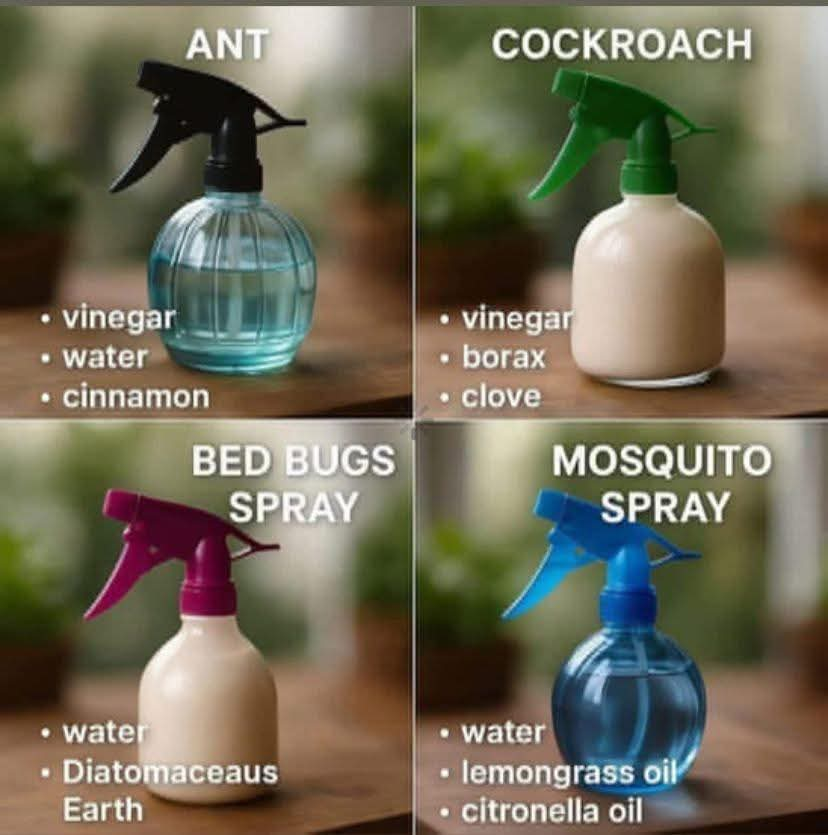Sure! Here’s a structured and engaging write-up for your natural insect repellent spray titled “Say Goodbye to Ants, Cockroaches, Bed Bugs & Mosquitoes—Naturally!”
Introduction
Insects like ants, cockroaches, bed bugs, and mosquitoes can turn any cozy home into a source of discomfort.
While commercial repellents may offer quick relief, they often come packed with harsh chemicals that could be harmful to both your health and the environment.
If you’re looking for a safer, greener alternative, natural DIY solutions can be incredibly effective and surprisingly easy to make.
Ingredients
Mix 1 cup water + 1 cup vinegar
Add 1 tsp cinnamon powder
Tip: Spray along kitchen corners and entry points.
Instructions
Begin by choosing a clean spray bottle. If reusing an old one, make sure it’s rinsed thoroughly to avoid mixing with any residual substances that could alter the mixture’s effectiveness.
Pour one cup of water into a mixing container or directly into the spray bottle. Water acts as the base and dilutes the acidity of vinegar while ensuring smooth application.
Next, add one cup of white vinegar to the water. Vinegar is a natural insect repellent and works especially well against ants and cockroaches due to its strong scent and acidic properties.
Add one teaspoon of cinnamon powder to the water-vinegar mix.
Cinnamon not only repels ants with its strong aroma but also has antifungal properties that add to the spray’s overall effectiveness.
Close the spray bottle tightly and shake it well to mix all the ingredients thoroughly. Make sure the cinnamon powder is well-dispersed in the liquid.
Before spraying large areas, do a patch test on a small hidden surface to ensure the mixture doesn’t damage finishes or discolor materials.
Once tested, spray generously along kitchen corners, cracks, crevices, windowsills, door frames, and any other common entry points where bugs might crawl in.
How to Make
Start by selecting a sturdy spray bottle, preferably one with a fine mist nozzle. This helps the solution distribute evenly over targeted areas without creating puddles.
Boil the water beforehand if your tap water contains high minerals, as this helps the spray remain clear and free of residues. Allow it to cool before using it in the mixture.
Add the cooled or room temperature water into the spray bottle. This will act as the carrier and dilute the solution for safe household use.
Pour in the vinegar, ensuring it mixes smoothly with the water. The acidic nature of vinegar is unpleasant to many insects and disrupts their scent trails, particularly for ants.
Add the cinnamon powder last. It may clump, so shake vigorously or stir well before pouring it into the bottle. The cinnamon’s aroma confuses insects and keeps them away from sprayed areas.
Label the bottle for future use and safety. You can note the date of preparation and ingredients used, especially if you plan to store it.
Store the spray in a cool, dark place. Shake well before each use, as the cinnamon powder may settle at the bottom over time.
Variations
For a stronger scent, consider adding essential oils like peppermint, eucalyptus, or tea tree oil, all of which have natural insect-repellent properties.
If bed bugs are your primary concern, incorporate a few drops of lavender oil, known to repel and even kill them when combined with vinegar.
Replace cinnamon powder with clove powder or bay leaf oil if you prefer different scents. These alternatives are also effective against household pests.
For a mosquito-focused spray, add a splash of lemon juice or citronella oil to increase repellency. Spray near windows and light sources where mosquitoes tend to gather.
If vinegar’s strong smell is bothersome, use apple cider vinegar for a milder aroma with similar benefits.
To enhance effectiveness on cockroaches, mix in a pinch of cayenne pepper. Its spiciness irritates their sensitive antennae and drives them away.
You can also brew a strong cinnamon tea using sticks, then mix it with vinegar and use that as your spray base instead of powder for less residue.
Tips
Always shake the bottle before use to redistribute the cinnamon powder throughout the liquid and ensure maximum potency.
Reapply the spray every couple of days or after cleaning to maintain an effective barrier against insects.
Avoid spraying directly on food surfaces or fabrics that could stain from cinnamon or vinegar.
For persistent infestations, combine this spray with other natural deterrents like diatomaceous earth or borax-based traps.
Clean surfaces before spraying to eliminate food particles and odors that attract bugs in the first place.
Use the spray as a preventative measure even when you don’t see bugs. Regular use helps deter insects from returning.
Keep out of reach of children and pets. While natural, the vinegar and cinnamon could still cause mild irritation if ingested or sprayed directly into eyes.
Conclusion
Nature provides us with powerful ingredients to combat everyday problems like insect infestations. With a simple blend of water, vinegar, and cinnamon, you can reclaim your home from pests without relying on harsh chemicals or expensive treatments.
This DIY spray not only protects your household but also supports a more sustainable, chemical-free lifestyle. Give it a try and enjoy a cleaner, bug-free home the natural way.
Let me know if you’d like versions for the other pests mentioned, like cockroaches or mosquitoes!
